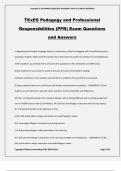Exam (elaborations)
TExES Pedagogy and Professional Responsibilities (PPR) Exam Questions and Answers
TExES Pedagogy and Professional
Responsibilities (PPR) Exam Questions
and Answers
A beginning-level English language learner in elementary school is struggling with his proficiency when
speaking in English. What could the teacher do to best help this student to develop his oral proficiency?
A)...
[Show more]
Preview 4 out of 34 pages
Uploaded on
November 11, 2024
Number of pages
34
Written in
2024/2025
Type
Exam (elaborations)
Contains
Questions & answers
Institution
Prep Tests
Course
Prep Tests
$12.49
100% satisfaction guarantee
Immediately available after payment
Both online and in PDF
No strings attached
Copyright © OLIVIAWEST2024/2025 ACADEMIC YEAR. ALL RIGHTS RESERVED




